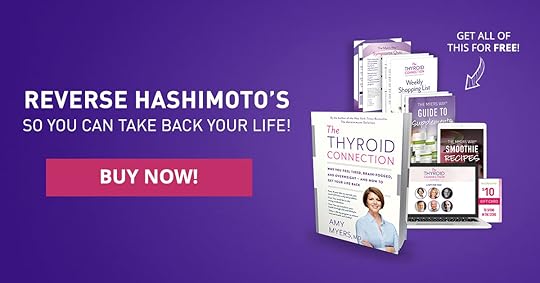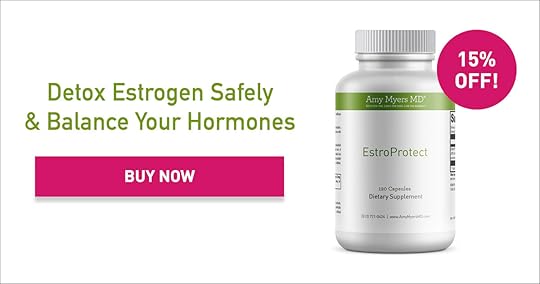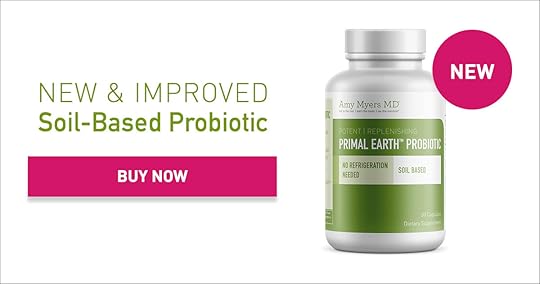Amy Myers's Blog, page 62
February 19, 2018
5 Tips for Choosing Autoimmune-Friendly Packaged Snacks
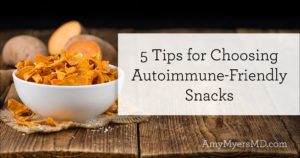
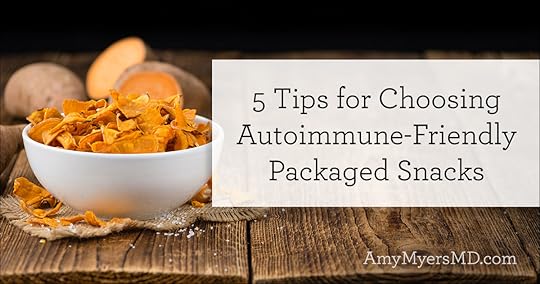
Let’s face it, life is busy! Between work, family, friends, and everything else on your plate, you likely have a lot going on. I know I do! When you’re starving because it’s 3:00 and you haven’t eaten since breakfast, it’s hard to stay on track. And if you’re following The Myers Way® Autoimmune Solution protocol, I know it can be especially tricky to navigate the grocery store for autoimmune-friendly snacks. Gluten and dairy can hide out under confusing names on ingredient labels, and so many “convenience” foods contain grains, nuts, or other inflammatory ingredients.
While you should aim to eat real, whole foods as much as possible, I understand that when you’re on the go sometimes you just need the convenience of a prepackaged snack. Even as the world has become flooded with packaged snacks that are organic, Paleo, and autoimmune protocol (AIP) friendly, it really comes down to being cognizant of reading ingredients. Many packaged foods are not really food at all, and products labeled “non-GMO,” “all natural,” or “gluten-free” can be loaded with sweeteners, preservatives, and other processed junk. And though a product might be Paleo, it could contain non-AIP ingredients, so you even have to be careful of those.
That’s why the key is to prepare for success when it comes to autoimmune-friendly snacks! Knowing what to look for will help you find real foods that won’t move you back up the autoimmune spectrum and disrupt all the progress you’ve made while following The Autoimmune Solution protocol. I’ve compiled the following tips to help you make smart choices when shopping for autoimmune-friendly packaged snacks.
1. Look for High-Protein Snacks
Research has shown that adding more protein to your diet helps you lose weight by sending the “stop eating” signal to your brain.1 Many snacks, especially those advertised as “nutrition” bars are really just desserts masquerading as a health food. Packed with carbs and sweeteners and lacking the necessary protein to keep you feeling full, these snack bars will cause a huge spike in your insulin levels, which will leave you hungry again as your blood sugar plummets and lead you to search for another quick fix. Even natural sweeteners including maple syrup, honey, and molasses can have this effect on your blood sugar. Over the long term, you will begin to feel sluggish, gain weight, and may even be setting yourself up for insulin resistance and diabetes.
Choosing a snack that is high in protein will help you avoid those pitfalls that drive you to overeat or reach for something that will derail your progress. For those of you have completed reintroduction phase of The Autoimmune Solution protocol, my NEW grab-and-go Chewy Chocolate Paleo Bar are perfectly balanced to handle those between-meal cravings! This travel-friendly snack contains a whopping 12 grams of clean-sourced grass-fed beef protein per bar, perfect for between meals and before or after a workout.
2. Look for Snacks High in Fiber and Healthy Fats
When looking for grab-and-go options, you also want to choose a snack that contains plenty of healthy fats and fiber to help sustain you through to your next meal and avoid the dreaded sugar crash. A study in the New England Journal of Medicine showed that people with diabetes who ate 50 grams of fiber a day were better able to control their blood glucose levels than those who ate much less.2 And healthy fats are necessary for providing your body with the energy it needs to work properly, assisting with vitamin absorption, and controlling inflammation.3
My Coconut Joy Fiber Bars will satisfy your craving for something sweet, and are excellent for keeping you full, energized, and focused. These decadent chocolate-covered coconut bars contain 11 grams of prebiotic fiber to support a healthy microbiome and blood sugar balance, and are rich in medium chain triglycerides (MCTs) to support fat burning and weight control.
And I’m super excited to introduce my NEW Mint Joy Fiber Bars, which have 13 grams of fiber and taste just like a peppermint patty! I keep one in my purse at all times just in case I get tied up and need a snack while I’m on-the-go. You can enjoy any of these bars once you’ve started the reintroduction phase of the Autoimmune Solution protocol.
3. Read the Label and When in Doubt, Go Without
Ingredient labels will be your roadmap for navigating the snack aisle. You’ll want to avoid any products that contain:
Gluten
Dairy (including whey protein)
Soy
Corn (including corn flour, cornmeal, and high-fructose corn syrup)
Eggs
Gluten-free grains and pseudo-grains (amaranth, millet, rice, oats, quinoa)
Nightshades (tomato, pepper, eggplant, potatoes)
Nuts, nut butters, and seeds
Legumes (beans, garbanzos, lentils, peas, peanuts)
Vegetable or seed oils
Yeast
GMOs
Gluten is the biggest culprit to keep an eye out for when scrutinizing food labels. In packaged snacks, gluten can hide out under the following additives and preservatives:
Artificial coloring
Baking powder
Caramel and other coloring/flavoring
Citric acid (can be fermented from wheat, corn, molasses, or beets)
Dextrins
Glycerides and diglycerides
Emulsifiers and stabilizers
Enzymes
Fat replacers
Food starch, modified food starch, and wheat starch
Glucose syrup
Malt
Maltodextrin
“Spices”
“Natural flavors”
Vegetable protein
And be sure to read the label every time, even on products you routinely buy because companies could change up the ingredients in their products at any time. If a product contains an ingredient that is unfamiliar to you or you’re unsure whether or not it contains foods that are non-Autoimmune Solution protocol compliant, you’re better off leaving it. It isn’t worth derailing your progress and risking a potential flare-up. Just remember my motto: when in doubt, go without.
4. Prepare for Success
Going to the grocery store and navigating shelves lined with seemingly endless choices can be overwhelming for anyone. Your best bet for making smart choices in the snack aisle is to come prepared with a list of options you know are AIP approved. Some of my favorite ready-made snacks include:
Avocado or other fresh fruit
Coconut yogurt (such as Culina)
Nature’s All organic freeze-dried fruit
Vital Choice wild salmon jerky or free range bison jerky
Jackson’s Honest Sweet Potato Chips
Bone broth (such as Bare Bones)
or
Artisana Raw Coconut Butter Squeeze Packs
Yucan Crunch Crackers
Paleo Angel Power Balls
Plantain chips (such as Terra)
I recommend the above brands for their clean ingredient lists and great taste, although you can certainly choose similar snacks made by other companies. Just be sure the brands you choose are certified organic and gluten-free, and don’t contain any inflammatory or toxic foods.
Try pairing foods with lower amounts of protein and healthy fats with a snack that is higher in those nutrients to make it more satisfying (such as freeze-dried fruit mixed with coconut yogurt).
5. Make Your Own
By far the best strategy to ensure your snacks are autoimmune-friendly is to make them yourself! That way, you can choose only healthful, clean, real-food ingredients that you know will not ignite an immune response and move you further up the spectrum. Plus, you can custom-make them to your own tastes, and probably save a few bucks too!
For some great snack ideas along with more than 150 other recipes specially designed to prevent and reverse the full spectrum of autoimmune diseases, you’re going to love my upcoming book, The Autoimmune Solution Cookbook, coming out May 8th! Be the first to get your copy by pre-ordering here.
SAVE on The Myers Way® Protein & Fiber Bars!
For the perfect on-the-go snack, try my delicious Protein and Fiber bars! My Coconut Joy Bars, Chewy Chocolate Paleo Bars, and NEW Mint Joy Bars:
Are perfect for a delicious paleo approved snack
Contain only small amounts of all-natural sugars
Have far superior flavor and texture than other ‘paleo’ bars
Are rich in medium chain triglycerides (MCT’s) to support weight loss and control
Contain prebiotics and soluble fiber to support a healthy digestive tract probiotic community
Buy any box of bars* now through Thursday March 8th at midnight CST to get a FREE copy of The Myers Way® AIP, Paleo & Keto Snack Recipes eBook, PLUS:
Save 5% on 1 box
Save 10% on 2 boxes
Save 15% & get FREE shipping in the continental US on 3 boxes!
*Discount applies to cases of the same flavor only
The post 5 Tips for Choosing Autoimmune-Friendly Packaged Snacks appeared first on Amy Myers MD.
February 17, 2018
Essential Oils 101 – Guest Post from Dr. Eric Zielinski
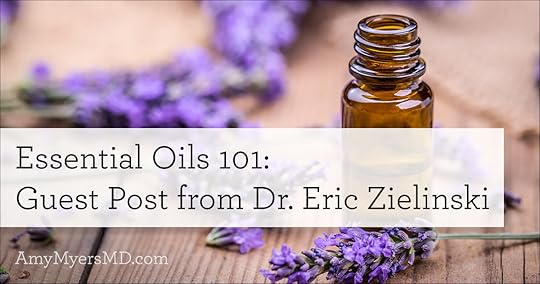

This is a guest post by Dr. Eric Zielinski. As an aromatherapist and public health researcher, he started DrEricZ.com in 2014 to help people learn how to use natural remedies like essential oils safely and effectively. Now visited b y five million natural health seekers every year, it has rapidly become the #1 source for Biblical Health and non-branded essential oils education online. An accomplished researcher with several publications and conference proceedings, Dr. Z currently sits as a peer-reviewer for multiple journals.
Aromatherapy and essential oils are getting a ton of attention right now, and many people are choosing to adopt them in place of toxin-filled air fresheners and artificially scented aerosol sprays, as well as adding them to homemade beauty products and all-natural DIY cleaners.
My wife and I began using essential oil aromatherapy in our home several years ago and in that time we’ve seen that it enhances our mood, sleep, health, and virtually every aspect of our lives! We’ve also noticed positive changes in our children from essential oils as well.
In this article, I’ll give you a quick introduction to essential oils and provide some simple ways you can start using them in your own life.
What Are Essential Oils?
The original scientific term used for essential oils is volatile oil. The volatile oil of a plant is the part that disperses quickly into the air. In fact, according to The Encyclopedia Britannica, they are are called essential oils because they were thought to represent the very essence of odor and flavor.1
The essential oil is the reason you can smell roses when you take a whiff of their blooms. It is released when you shake the plant itself or walk through a garden of roses.
Essential oils can be located in a plant’s roots, stems, leaves, and blossoms, and they are multifaceted, offering a range of therapeutic effects that can vary according to their composition.
A plant’s essential oil is a component of the plant itself, and it contains thousands or even millions of molecules that contribute to the plant’s needs and uses. This is key because the chemical composition of an essential oil can help us determine how we can best utilize it for scent, mood, culinary, or health purposes.
The essential oils that you can purchase online or at health food stores are extracted from plants using steam distillation to release droplets of essential oils. These oils are then collected to create a concentrated solution. Since it’s an extraction of only a very small part of the plant, it takes large volumes of each plant to create even a small bottle of essential oils.
It’s important to understand that because essential oils are a highly concentrated extraction of a plant, they should be used differently (with greater care and for more specific use cases) than you would the plant itself.
For example, cinnamon is a spice that comes from cinnamon bark, and it includes the cinnamon essential oil, as well as all of the other component parts of cinnamon bark. As such, it can be added to your tea, sprinkled into dessert recipes, etc.
Cinnamon essential oil, however, only has the essential oil component of cinnamon bark and is highly concentrated. So it should be used for the specific benefits those molecules provide – which in the case of cinnamon is as an antibacterial.
While the essential oil does still taste great and can be used in cooking with proper care (more on that below) it can also be a dermal irritant, so you wouldn’t add it into your tea the same way you would a stick of cinnamon because it could damage your mouth and throat.
3 Ways to Use Essential Oils
Essential oils can be used by the following methods:
Inhalation
Topical Application
Home and Beauty Products
Inhalation
Inhaling essential oils is the oldest and safest way to obtain their therapeutic benefits. To obtain their direct effects, you can breathe in their steam or inhale them directly from the bottle or from a few drops on a cloth. This method helps disperse the volatile oil to your respiratory system and mucous membranes.
Topical
Topical use provides a more direct approach to applying essential oils compared to inhalation. The oil is absorbed through the layers of your skin, instead of being exposed to your mucus membranes.
The safest and preferred way to apply essential oils topically is to dilute them using a carrier oil such as olive, coconut, jojoba, or avocado oils. Using a carrier oil helps ensure that the application doesn’t cause a skin irritation, and the oils used often have their own health benefits themselves.
DIY Products
Essential oils can also be used when making your own toxin-free home and beauty products. In addition to adding wonderful scents, essential oils offer antimicrobial properties for household cleaners, and mood and relaxation benefits for body and beauty products.
**Some people advocate ingesting essential oils. However this is hotly debated and not all types of essential oils are safe to ingest. Unless you are working personally with an essential oils expert, it is not advised to ingest essential oils.
3 Essential Oil Blends to Support Your Brain, Mood & Sleep
Here are a few of my family’s favorite essential oil blends to help support optimal focus, deep breathing, and restorative sleep.
We simply add up to 6-10 total drops into a diffuser or pot of simmering water and let it disperse throughout the room.
Focus Blend: cedarwood, frankincense, sandalwood, vetiver
Deep Breathing Blend: cardamom, eucalyptus, lemon, peppermint, rosemary, tea tree
Sleepy Time Blend: roman chamomile, lavender, and vetiver
These blends are a great place to start if you’re just beginning with essential oils and want to explore how they can support your mood, sleep, and health.
Free 10-Part Masterclass: Everything You Need to Know to Get Started with Essential Oils
Eric Zielinksi and his wife, Sabrina, have a special gift for you! They recently filmed a 10-Part Video Masterclass that will give you the confidence that you need to make health-supporting remedies for your body & non-toxic natural recipes for your home with essential oils.
And, because you are part of The Myers Way® community, they are giving YOU a FREE access pass to their Global Premiere of Essential Oils for Abundant Living this February 20 – March 1!
Wherever you are in your essential oil journey, I guarantee you will discover some golden nuggets that you can start putting into practice today!
Consider this an all-you-can-eat buffet of expert tips and DIY hacks to help you and your family enjoy abundant health with essential oils!
The post Essential Oils 101 – Guest Post from Dr. Eric Zielinski appeared first on Amy Myers MD.
February 16, 2018
Key Lime Pie Smoothie


If you like key lime pie, then you’ll love this Key Lime Pie Smoothie! Start your day with this smoothie for a refreshing energy boost that will keep you going until lunchtime!
This Key Lime Pie Smoothie is bursting with bright, citrusy notes combined with the perfect amount of creaminess, thanks to the frozen banana and coconut milk!
Full of healthy fats and protein, this smoothie will keep you feeling full and satisfied–without a spike or crash in your blood sugar. Enjoy!
Key Lime Pie Smoothie
CourseBeverage, Breakfast, Dessert
ProtocolAutoimmune Solution (AIP), Candida Control & SIBO, Paleo, Thyroid Connection
Servings1 smoothie
Ingredients
1scoop
The Myers Way® Vanilla Paleo Protein
2Tbsp
fresh lime juice
1/2
frozen banana
1cup
full fat coconut milk
1/2tsp
cinnamon
1cup
spinach(optional)
Instructions
Place all ingredients in high-speed blender and blend until desired consistency is reached.
The post Key Lime Pie Smoothie appeared first on Amy Myers MD.
February 14, 2018
Video: Hidden Hazards of Electromagnetic Fields (EMFs) and What to Do About Them

In our modern world, we are surrounded by electromagnetic fields (EMFs) created by our televisions, cell phones, computers, microwaves, and other electronic devices.
This technology has only been around for a few decades, so we really don’t know the full extent of the effects EMFs have on our health. The few studies that have emerged, however, are pretty scary–especially for those of us who have an autoimmune condition or are high on the spectrum.
I went live on my Facebook page with Green Smoothie Girl, Robyn Openshaw, to discuss how EMFs are taking a big toll on our health and some simple strategies for minimizing our exposure to them!
Resources I mentioned:
EMF Action Plan
Glutathione
Amber Glasses
The post Video: Hidden Hazards of Electromagnetic Fields (EMFs) and What to Do About Them appeared first on Amy Myers MD.
February 12, 2018
Understanding The Autoimmune Spectrum and How to Get Your Life Back

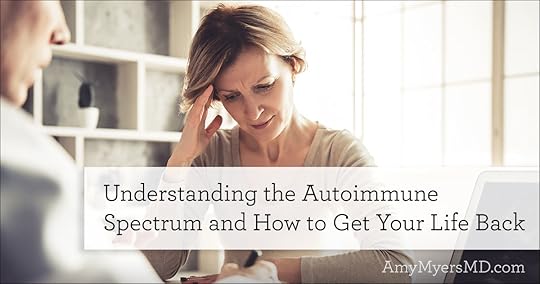
Conventional medicine tells us that autoimmunity is a black-or-white issue–you either have it or you don’t. And if you have it, that means you are destined to a life of painful symptoms and harsh medications. However, that’s simply not true.
Instead, there’s what I call “the autoimmune spectrum” and how much inflammation you have determines where you fall on that spectrum. I coined this term back when I first began writing about autoimmunity, and thanks to my book The Autoimmune Solution, it’s now become the established term in functional medicine to explain how autoimmune conditions develop and, more importantly, how to reverse them.
My goal is to empower you by providing you with the tools I wish I had when conventional medicine failed me during my own struggle with autoimmune disease. I want to help you get to the root of your autoimmunity so you can take back your health and avoid the harsh treatments that I was forced into by conventional medicine.
The good news is that by reducing inflammation, you CAN work your way down the autoimmune spectrum and reverse your condition! By understanding the factors that are contributing to your inflammation, you can get to the root cause of your autoimmunity and start leading your best life.
Autoimmunity: Your Immune System Gone Rogue
At its core, autoimmune disease is a disease of the immune system. Aside from the nervous system, the immune system is the body’s most complex system, made up of the following:
Digestive system
Skin
Tonsils
Bone marrow
Lymph nodes
Spleen
Thin skin on the inside of your nose, throat, and genitals1
All of these tissues, organs, and cells work together to keep your entire body healthy.
Under our current medical system, autoimmune diseases are not recognized as diseases of the immune system as a whole. Instead, they are treated as diseases of particular organs. However, when you have autoimmunity, it means that somewhere along the way your immune system went rogue and began attacking your own tissues. It could be your thyroid under attack, your intestines, your skin, your brain, your pancreas, or another organ.
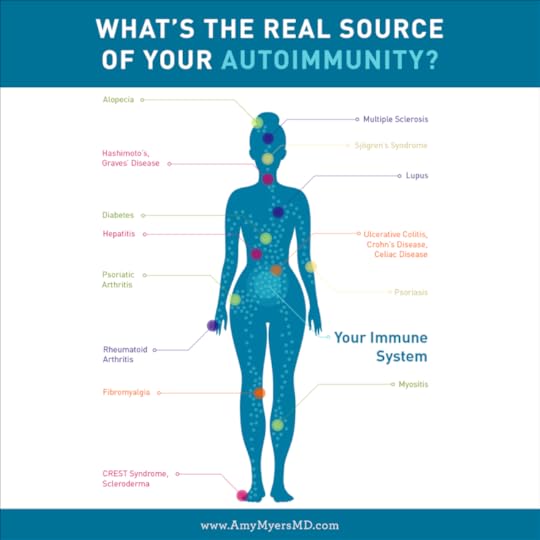
No matter what part of your body is under siege, the underlying problem is within your immune system. This means in order to treat, prevent, and reverse your autoimmune disease you’ll need to get your immune system back under control.
Inflammation and The Autoimmune Spectrum
So what caused your immune system to go rogue in the first place? One word: inflammation. Nearly everyone in our modern society has at least some inflammation thanks to our modern lifestyles. The five factors that I’ve identified in my patients that lead to chronic inflammation are diet, leaky gut, toxin exposure, infections, and chronic stress, or a combination of these factors.
For many people, diet is their primary source of inflammation, particularly gluten and dairy, as well as corn, soy, grains, and legumes.
Even those of us with a clean diet are exposed to thousands of environmental toxins that contribute to inflammation every day in the form of plastics; pesticides, herbicides, and hormones in our food; heavy metal exposure from fish and dental fillings; air and water pollution–the list goes on.
Family history can also impact where you fall on the spectrum. The more relatives you have with an autoimmune condition, the higher your risk is, especially when it’s a first-degree relative such as a parent or sibling. Even so, genetics only accounts for about 25% of the chance that you will develop an autoimmune disorder. That means the remaining 75%of the picture is environmental — and therefore up to you. I find that an incredibly empowering statistic.
Once you figure out where you fall on the spectrum, you can assess your risk for developing autoimmunity–or, if you’ve already been diagnosed with an autoimmune disease, take the proper steps to reduce inflammatory factors in your life to work your way back down the spectrum.
The Autoimmune Spectrum
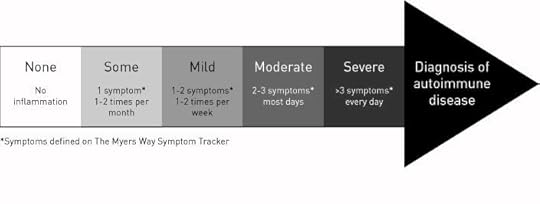
At the low end of the autoimmune spectrum are those of you who are only moderately inflamed. You may get occasional symptoms such as acne, digestive issues, and fatigue, although these tend to come and go and you haven’t begun to show signs of illness.
Toward the middle of the spectrum are those of you who experience symptoms of chronic inflammation that have not yet turned into full-blown autoimmune disorders. These conditions might include joint pain, obesity, allergies, muscle aches, fatigue, and digestive issues. Although you don’t have an autoimmune condition at this point, you are at significant risk to develop one if you don’t address your inflammation.
Finally, at the high end of the spectrum are those who can officially be diagnosed with an autoimmune disease. While conventional doctors would doom you to being on medications for life or take other drastic measures to control your autoimmunity, there are simple lifestyle changes you can adopt to live a long, healthy, and symptom-free life.
By addressing the root causes of your inflammation, you can stop your immune system’s attack on your tissues and work your way back down the spectrum. As I explain in The Autoimmune Solution book and online program, I have a five-step approach to helping you do exactly that.
Repair your gut
Optimize your diet
Tame the toxins
Heal your infections
Relieve your stress
Life Happens: Moving Back Up the Spectrum
Right before I wrote my second book, I was at the healthiest point of the autoimmune spectrum. Because I was feeling great and all of my autoimmune markers were negative, I did what I have many of my patients do: I added more variety into my diet. Now don’t get me wrong; I didn’t go crazy and start eating gluten, but I did reintroduce some of the foods that I knew I could tolerate in moderation, including rice, legumes, and scrambled eggs. And because I was traveling, I was eating out more, which meant that I was sometimes eating foods that were not 100 percent certified organic. And I was enjoying a gluten-free and dairy-free dessert on occasion.
Then I became really, really sick. Several of my inflammatory markers were higher than I wanted them to be, meaning I was moving in the wrong direction on the autoimmune spectrum. I knew something was wrong, and I needed to figure out what. After lots of testing and lots of digging, my husband, Xavier, and I discovered that there was toxic mold in our house.
We moved to a newly built apartment, and I became even more ill from the off-gassing of the building materials, wall-to-wall carpeting, and composite wood cabinets. I became so sensitive to certain chemicals that even just leaving the house was a risk because I never knew what would cause me to break out in a bright red rash. I became so sick that I actually slept on our outdoor balcony for a month, just so I could know that I was breathing fresh, clean air at night!
The Myers Way® for Life
The important lesson in my story is that life happens to all of us. Even the healthiest of us can move in the wrong direction on the autoimmune spectrum and experience symptoms again because of circumstances that are out of our control. That’s why it’s so important to remember that you always have the power to work your way back toward symptom-free optimal health by getting 100 percent back on board with The Myers Way®. That’s what I did, and I am back to feeling great again after detoxing from the toxic mold and following my five-step approach to health that I lay out in The Autoimmune Solution.
That’s why I call my program The Myers Way®–because it really is a way of life. Even when life throws you a curveball, you can control your place on the autoimmune spectrum using the five steps of The Myers Way®.
In addition to reversing my own autoimmune condition and working my way back down the spectrum, I’ve seen thousands of patients successfully reverse their conditions using The Myers Way®, and have empowered thousands more through my book The Autoimmune Solution and my 6-week online program, The Autoimmune Solution program, and you can do the same too!
Free Training: 5 Ways to Reverse Autoimmune Disease (That Your Doctor Won’t Tell You)
My FREE online training course, 5 Ways to Reverse Autoimmune Disease (That Your Doctor Won’t Tell You) is a great place to start if you’ve been diagnosed with an autoimmune condition and have had it with conventional medicine. I created this training to empower any of you out there dealing with autoimmunity to uncover the true root cause of your disease, and realize you CAN reverse your condition using surprisingly simple lifestyle changes.
In this training, you’ll learn how optimizing your diet, repairing your gut, taming the toxins in your life, healing your infections, and relieving your stress are all steps you can take to reduce your inflammation and stop your immune system from attacking your tissues. You’ll feel better, have more energy, and may even be able to ditch your medications for good by following this protocol!
Are you ready to take back your health? Register now!
The post Understanding The Autoimmune Spectrum and How to Get Your Life Back appeared first on Amy Myers MD.
February 10, 2018
3 Reasons Your Doctor Missed Your Hashimoto’s Diagnosis
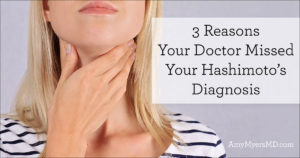
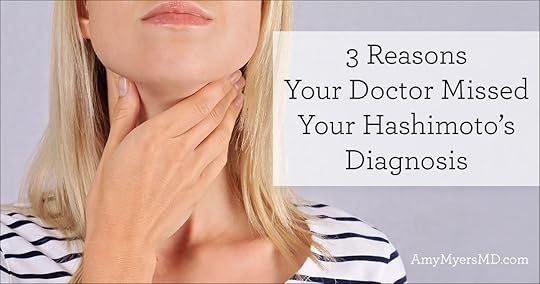
Do you struggle with fatigue, brain fog, weight gain, constipation, mood imbalances, or cold hands? And have you visited your doctor only to be brushed off or told that you’re fine?
Unfortunately, this is all too common in conventional medicine. And, as I explain in my book, The Thyroid Connection, it’s often an undiagnosed thyroid condition called Hashimoto’s that’s behind your symptoms.
Let me tell you a story that may sound familiar to you.
When Susannah first came into my office with complaints of exhaustion, depression, and weight gain, she had already seen three different doctors who could not accurately diagnose or treat her condition. “They kept telling me I was fine because my labs were normal,” Susannah told me. “But I can’t be okay if I’m feeling like this!”
I have seen countless patients in Susannah’s situation whose doctors brushed off their symptoms as stress, age-related, or simply “women’s issues”, and after diving deep into their medical history and running a complete thyroid panel I was able to determine that it was indeed Hashimoto’s they were dealing with.
After reviewing Susannah’s medical records, I could see the problem. Each of her doctors had only looked at part of her condition. The blood tests they ran showed Susannah’s thyroid hormone levels to be within normal range, yet those tests did not tell the full story. She did have thyroid dysfunction–her doctors simply could not see it in the labs they ordered. So even if your doctor tells you that your thyroid levels are normal, you could very well have Hashimoto’s.
In this article, we’ll take a look at signs you’re dealing with Hashimoto’s, and the reasons why your doctor may have missed your diagnosis.
What is Hashimoto’s?
Your thyroid produces hormones that help regulate nearly all of your bodily functions, including metabolism, heart rate, body temperature, menstrual cycles, and cholesterol levels.12 Hashimoto’s is an autoimmune disorder in which your immune system creates antibodies that attack your thyroid gland, causing hypothyroidism, which is when your thyroid under produces its hormones.
When this occurs, all of your metabolic processes slow down, leading to a whole range of symptoms, including:
Fatigue and feeling exhausted even after sleeping 8-10 hours
Brain fog, difficulty concentrating, poor memory
Weight gain or inability to lose weight
Cold hands or feet, low body temperature
Hair loss or thinning, brittle hair
Constipation
Hormonal imbalances including PMS, irregular periods, and low sex drive, infertility
Dry skin or brittle nails
Mood imbalances such as anxiety, depression, and mood swings
Decreased heart rate
Neck swelling, snoring, or hoarse voice
Hashimoto’s is the leading cause of hypothyroidism in the U.S.3 As I explain in my book, The Thyroid Connection, we are currently in the midst of a thyroid epidemic, with around 27 million Americans facing some sort of thyroid dysfunction. Women are up to eight times more likely to develop a thyroid condition than men, and 60% of those living with thyroid dysfunction are unaware they even have an issue.4
Developing thyroid dysfunction is much more likely for those who already have a preexisting autoimmune condition, so it’s important to get tested if you have this risk factor or any of the other signs you may have Hashimoto’s.5
3 Reasons Your Doctor May Have Missed Your Thyroid Diagnosis
If you are one of the millions of patients yet to receive an accurate diagnosis of underlying thyroid dysfunction, it could be that your doctor simply did not run the proper tests. Here are 3 reasons why.
1. They didn’t check your thyroid levels
The symptoms of Hashimoto’s can be vague, leading doctors to brush them off as “women’s issues,” stress, aging, or related to some other disease. Conventional doctors typically don’t start checking your thyroid levels until you’re in your 40s or 50s, so if you’re in your 20s or 30s, they probably assume your symptoms are part of another condition (such as fatigue caused by iron deficiency). If you’re a man, they might not check your thyroid levels at all since men are considered to be at low risk for thyroid dysfunction. And if you have another autoimmune disease, your doctor might just focus on that condition as the source of your symptoms and not bother to check your thyroid levels as a result.
2. They didn’t run a complete panel
Maybe your doctor did run a thyroid test and declared your thyroid levels normal, even though your symptoms continue to persist. Chances are, your doctor did not run a complete panel. Most conventional doctors only check your Thyroid Stimulating Hormone (TSH), which is considered the go-to test for the diagnosis and treatment of thyroid dysfunction.6 However, measuring this hormone alone does not tell the whole story, and the results can be often counterintuitive and confusing. For a more accurate diagnosis, you’ll also want to check your Free T4, Free T3, and Reverse T3 hormone levels.
Here’s an overview of what each one measures:
Free T4 – The Storage Form: T4 is the thyroid’s primary output. T4 is an inactive form of thyroid hormone that gets stored in your body’s tissues so that it’s ready to use when needed. I like to measure Free T4 (FT4) because it shows how much T4 is still circulating in the bloodstream and available to act in the body.
Free T3 – The Gas: Free T3 (FT3) is the active form of thyroid hormone. When each local area of your body determines it needs more energy, it converts the storage form of T4 into FT3. These hormones attach to receptors inside of your cells to power your metabolic processes, so I like to think of them as the gas. It is vital to measure your FT3 levels because your body might not be converting T4 to FT3 very well. This is one of the most common causes of hypothyroidism symptoms I see in my practice.
Reverse T3 – The Brakes: Your body uses a portion of the T4 to create Reverse T3 (RT3), which attaches to the receptors for FT3 in order to slow down your metabolic processes. For that reason, I call RT3 the brakes. If RT3 levels are high, you are likely converting too much T4 to RT3 and not enough to FT3. This can cause hypothyroid symptoms even if your TSH and T4 levels are optimal.
TPOAb and TgAb – Antibodies: In addition to checking your thyroid hormone levels, there are also two main types of thyroid antibodies that your doctor should check for. Thyroid peroxidase antibodies (TPOAb) attack the enzyme responsible for synthesizing thyroid hormones, and thyroglobulin antibodies (TgAb) attack thyroglobulin, which your thyroid uses to produce its hormones. In patients with Hashimoto’s disease, both TPOAb and TgAb levels are elevated. Determining whether you have Hashimoto’s, as opposed to just an underactive thyroid, is key because once you have one autoimmune condition, you are three times as likely to develop another.
I recommend ordering all of the thyroid tests listed below for obtaining a full picture of a patient’s thyroid health.
TSH
Free T4
Free T3
Reverse T3
Thyroid Peroxidase Antibodies (TPOAb)
Thyroglobulin Antibodies (TgAb)
For a complete description of what these tests measure and how to interpret the results, check out my book The Thyroid Connection.
3. They didn’t use optimal reference ranges
Okay, so you finally got your doctor to order the full range of thyroid tests, and your results still do not indicate Hashimoto’s or thyroid dysfunction. This is because many doctors rely on “normal” reference ranges, which are too broad and often lead to unreliable results. When they created the lab reference ranges for a healthy thyroid, it was later discovered that they had included people who already had thyroid dysfunction! In 2003, the American Association of Clinical Endocrinologists recommended narrower lab reference ranges, yet even today many doctors and laboratories have not updated their practices.
In my experience, I have found the following reference ranges to be optimal for my patients (and myself!):
TSH 1-2 UIU/ML or lower (Armour or compounded T3 can artificially suppress TSH)
FT4 >1.1 NG/DL
FT3 > 3.2 PG/ML
RT3 less than a 10:1 ratio RT3:FT3
TPO – TgAb – < 4 IU/ML or negative By using these guidelines—and listening to your body—you can be sure that you are getting the most accurate information about your thyroid health and your medication needs.
Reverse Hashimoto’s and Take Back Your Life
Are you ready to banish brain fog, fatigue, weight gain, and all of the other symptoms holding you back from being your best self? Then be sure to check out my New York Times Bestseller, The Thyroid Connection. In this book, you will learn the true underlying causes of your symptoms and how to work with your doctor to get the proper testing and thyroid medication you need to start feeling your best. My step-by-step instructions will help guide you on how to use simple yet proven dietary and lifestyle changes to help reverse your condition and take back your life!
The post 3 Reasons Your Doctor Missed Your Hashimoto’s Diagnosis appeared first on Amy Myers MD.
February 9, 2018
How to Access Your Program
Your program and eCourse lessons are accessed through your desktop, tablet, or mobile device, inside your online programs dashboard. We recommend using a desktop or laptop to access the worksheets and guides so that the files are easy to store and print.
For best results, please avoid using Internet Explorer or Microsoft Edge for your internet browser. We recommend Google Chrome or Firefox.
Step 1: Login at https://store.amymyersmd.com/account/login
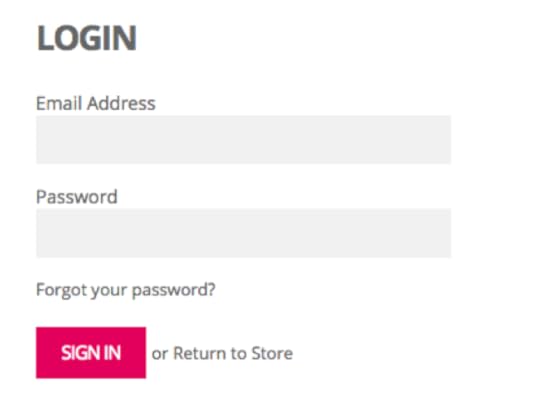
Step 2: From the My Account menu, choose My eCourses & Meal Planning Tool

Step 3: Sign in at https://members.amymyersmd.com/
This login information is provided and emailed to you upon purchasing an eCourse or Meal Planning Tool. Please note, that this password can be changed to match your Store account password by clicking Lost your password? on the Members login page.

Step 4: From the Dashboard, click My eCourses

Step 5: Select your course from the Active Courses tab
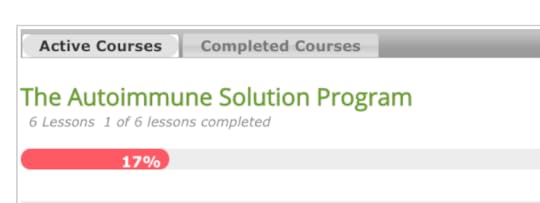
Other Helpful How To’s
Here are a few other helpful tips to help you use your program:
How to Reset Your Password
If you need to reset your Store account password, click the Forgot your password? Link on the login screen.
If you need to reset your Member profile password, click the Lost your password? link on the login screen.
How to Take Lesson Quizzes
If you are completing The Autoimmune Solution Program your weekly symptom tracker is your “quiz”. Please be sure to complete your entry into the progress tracker each week and the program will show that the quiz is complete.
What to Do if You Accidentally Marked Your Program as Complete
Each program and eCourse has a green “mark as complete” button below it. If you accidentally mark your program as complete while you are still going through it, don’t worry! You can still access the program from your eCourses page, it will just be under Completed Courses, and you can go through all of the content the same as you would if it were not marked complete.
The post How to Access Your Program appeared first on Amy Myers MD.
Valentine’s Day Chocolate Truffles


Valentine’s Day is just around the corner, which to me means chocolate, chocolate, and more chocolate! Instead of buying one of those heart-shaped boxes of chocolate filled with sugar, dairy, and other bad-for-you ingredients, why not make your own?
These Valentine’s Day Chocolate Truffles are melt-in-your-mouth delicious and make a perfect gift for that special someone in your life (or yourself!). Full of heart-healthy fats from avocado and coconut butter, you will fall in love with these Valentine’s Day Chocolate Truffles!
Use carob powder in place of the cocoa powder to make these Autoimmune Solution protocol-friendly! Enjoy!
Valentine's Day Chocolate Truffles
CourseDessert, Snack
ProtocolAutoimmune Solution (AIP), Candida Control & SIBO, Paleo
Servings10 truffles
Ingredients
Filling
1
avocadoflesh scooped out
3Tbsp
coconut butter
3Tbsp
unsweetened cocoa powder(or carob powder)
6drops
liquid Stevia
1 Tbsp
maple syrup(optional)
Chocolate Coating
1/2cup
coconut oilmelted
1/2cup
unsweetened cocoa powder(or carob powder)
2drops
liquid Stevia
Other options for coating
unsweetened shredded coconut
unsweetened cocoa powder(or carob powder)
freeze-dried fruitcrushed
Instructions
Place all filling ingredients in a food processor. Process until combined. Remove from food processor and place in refrigerator to let set - 30 minutes to 1 hour.
Remove from refrigerator. Roll into 1 inch balls.
For coating: combine coconut oil, cocoa powder, and stevia. Dip truffles in coating. Place on a parchment lined sheet pan or platter and place in refrigerator until solid - about 30 minutes.
Optionally, instead of chocolate coating, you can roll-in unsweetened shredded coconut, unsweetened cocoa powder or carob powder, or crushed freeze-dried fruit.
The post Valentine’s Day Chocolate Truffles appeared first on Amy Myers MD.
February 5, 2018
9 Causes of Estrogen Dominance and What to Do About It
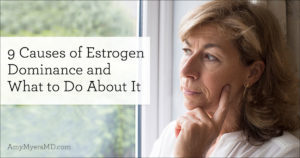
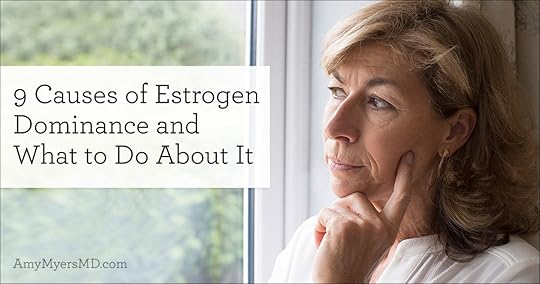
Are you struggling with infertility, PMS, mood swings, weight gain, or low libido? If so, you could be dealing with a hormone imbalance. Having too much estrogen–known as estrogen dominance–is not only linked to a set of frustrating and uncomfortable symptoms; it also puts you at risk for a whole host of chronic issues. From fatigue and irritability to autoimmune conditions, thyroid dysfunction, and cancer, estrogen can wreak havoc on your body if it’s not in proper balance with your other reproductive hormones, such as progesterone.
And here’s the hard truth – estrogen dominance is at an all-time high. We’re seeing the rates spike across the board, in both women and men, across age ranges. And the rates of cancers and chronic illnesses linked with estrogen dominance are on the rise right along with it.
That’s because we are being constantly bombarded by xenoestrogens (industrial chemicals that mimic the behavior of estrogens) in our modern environment. They’re everywhere–in our food, personal care products, furniture and clothes. From the water we drink to the food we eat, you encounter a shocking number of these endocrine-disrupting xenoestrogens in the course of a day, without even knowing it.
It scares me when I think about how toxic our world has become, especially since I am a mother to a little girl. That’s why I’m even more passionate about arming you with the knowledge you need to make smart choices for yourself and your family.
In this article, I’ll walk you through what estrogen dominance is, how you’re being exposed to xenoestrogens, and simple, diet and lifestyle changes you can make to minimize your risk, naturally clear estrogen from your system, and maintain an optimal hormonal balance.
When Estrogen Becomes a Problem
Everyone naturally produces the hormone estrogen in your adrenal glands and stored fat tissue, as well as the ovaries in women and the testes in men. Estrogen is necessary for many important functions such as childbearing, keeping cholesterol in check, and protecting bone health.1 It’s when your estrogen levels get out of balance with your other hormones that it can lead to a number of issues in both men and women.
Symptoms of Estrogen Dominance
Women:
Weight gain, mainly in hips, waist, and thighs
Menstrual problems such as light or heavy bleeding
PMS
Fibrocystic breasts
Uterine fibroids
Fatigue
Loss of sex drive
Depression or anxiety
Men:
Enlarged breasts
Sexual dysfunction
Infertility
Conventional medicine tells us that it’s your lifelong exposure and total amount of estrogens that poses a problem and causes cancer. For instance, if you started your period at a young age, or had children late in life or not at all, you would be at a higher risk. However, that’s not entirely true. It’s really your lifelong exposure to bad metabolites of estrogen that increases your cancer risk. Let me explain.
Estrogen is metabolized by the liver through three different pathways. Depending on the pathway, estrogen will be converted into good or bad metabolites. The 2-hydroxy metabolic pathway is considered good as it has the lowest risk for cancer and other problems. Meanwhile, the 16-hydroxy and 4-hydroxy pathways are considered bad and associated with higher risks of breast cancer.2 Using the 2-hydroxy pathway, your body produces good estrogen metabolites, which support healthy mood, libido, breast tissue, and reproductive health. When your body is converting too many of your hormones using the 16-hydroxy and 4-hydroxy pathways, that’s when you experience estrogen dominant symptoms such as irritability, vaginal dryness, and PMS, and are at a higher risk of developing cancer.
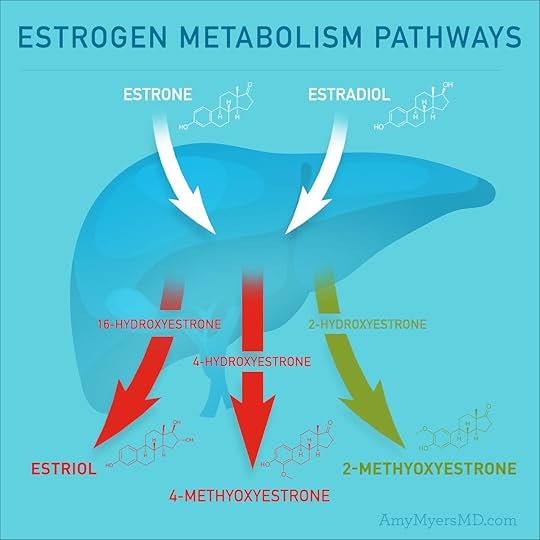
So it’s not about your total estrogens. It’s about your total estrogen metabolites. Nutritional status, liver health, stress, diet, and sleep all determine which metabolic pathways are used. Gene mutations such as COMT and MTHFR also impair your ability to methylate and detoxify your hormones, as do a number of environmental and lifestyle factors that I’ll get into more in depth later.
Health Risks Associated with Estrogen Dominance
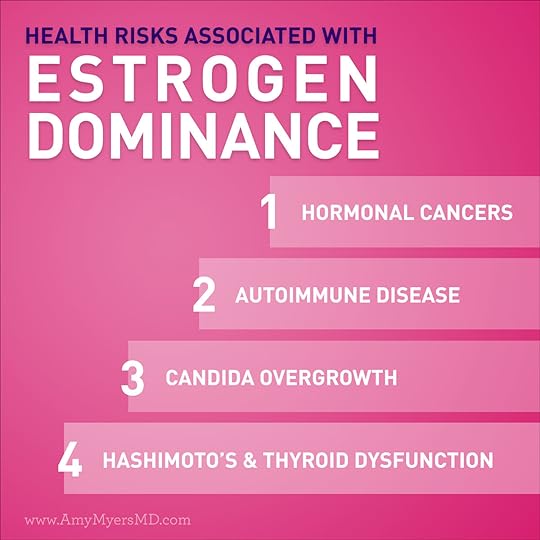
Hormonal Cancers
By far the biggest risk associated with estrogen dominance is hormone-dependent cancer including breast cancer in both women and men, uterine and ovarian cancers in women, and prostate cancer in men.3 Breast cancer specifically is more rampant than ever. One in eight women will get breast cancer in her lifetime.4
Hormonal cancers are associated with stored fat, which produces the most potent form of estrogen, estradiol. This type of harmful estrogen is more difficult for your body to detoxify, leading to more circulating estrogen and “bad” estrogen metabolites.
Autoimmune Disease
In some autoimmune conditions, high levels of estrogen can enhance the inflammatory response of the immune system, increasing the antibodies that attack your body’s own tissues. Although it’s entirely a clear cut issue. Estrogen is actually protective for some autoimmune conditions, such as multiple sclerosis (MS). It seems to be the sharp fluctuations in estrogen levels (such as those that happen around childbirth and menopause) that contribute to autoimmunity. It also has to do with the types of estrogens in your system, and whether they are your natural hormones or the synthetic xenoestrogens that exist in our environment.
Because women tend to be more susceptible to estrogen dominance, this helps explain why autoimmune conditions are so much more common among women.5
Hashimoto’s and Thyroid Dysfunction
Excess estrogen increases levels of thyroid binding globulin (TBG) which is the protein that allows your thyroid hormones to travel through your bloodstream. When thyroid hormones are attached to TBG they remain inactive, so your thyroid hormones can’t be stored in your tissues or converted to their active form in order to fuel your body and metabolic processes. I explain this more in depth in my book, The Thyroid Connection.
Candida Overgrowth
Estrogen dominance also plays a factor in Candida overgrowth. Research shows that exposing Candida albicans to estrogen increases its virulence, which is why women taking birth control or traditional hormone replacement therapy tend to be more susceptible to yeast infections.6
Causes of Estrogen Dominance
Every day we are under constant attack by environmental toxins that lead to the creation of bad estrogen metabolites. Hormone-mimicking xenoestrogens combined with your own diet and lifestyle habits can all contribute to estrogen dominance.
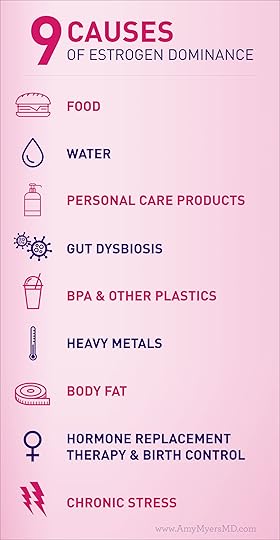
1. Food
By far one of the biggest sources of excess estrogen is our modern diet. Commercially raised animals are injected with growth hormones to make them grow bigger and faster or increase milk production. These hormones make their way into your food where they can disrupt your own natural hormone balance.
Plus, any of the pesticides, herbicides, and fungicides found on conventional produce are known endocrine disruptors that interfere with your natural hormone activity and metabolism.7 While they may only exist in small quantities on individual fruits and vegetables, the cumulative effect quickly adds up and hasn’t been studied enough to say what the long-term effects might be.
2. Water
Unfortunately, our water has become heavily polluted with hormone-disrupting compounds including pesticides and fertilizers, synthetic and natural estrogens from livestock and prescription medications, and an unknown number of industrial chemicals from chemical plant runoff or the disposal of plastics and chemicals in landfills.8
Coal-burning plants emit over 70,000 pounds of mercury in the into the air each year, which then settles into our water and impacts our hormonal levels (more on that below).
3. Personal Care Products
Cosmetics, lotions, shampoos, soaps, toothpastes, and the numerous other body products we use often contain parabens, phenoxyethanol, phthalates and other compounds that all have estrogenic activity.9 And since the average person uses 10-15 body products a day, with a total of 126 different ingredients, this exposure can quickly add up!
You’d think that beauty products would be regulated for safety. However, you’d be surprised to learn that they are regulated by an internal review board, so they’re really just regulating themselves, leading to the inclusion of all sorts of hidden endocrine disruptors in these products you use every day.
Xenoestrogens in skin care products are especially harmful because they are absorbed directly into your tissues, and so never have the chance to be detoxified through your liver.10 Be wary of deodorants or other personal care products that contain an unspecified “fragrance,” as this can be virtually anything and it tends to be a catch-all term for hidden phthalates or other hormone-disrupting chemicals.
4. Gut Dysbiosis
Your gut microbiome regulates circulating estrogen using an enzyme known as beta-glucuronidase. When your microbiome is out of balance, as in the case of Small Intestinal Bacterial Overgrowth (SIBO), these enzymes can’t properly metabolize estrogens, which leaves you more susceptible to breast cancer and other conditions caused by estrogen dominance.11
5. BPA and Other Plastics
Plastic in all its forms, including in water bottles, food wrap, and storage containers, contain hormone mimicking xenoestrogens that can leach into what you’re eating or drinking and cause major problems for your health. Even products marked “BPA-free” are not safe, and in fact contain chemicals whose effects aren’t as well-known.12
And, microwaving, dishwashing, and exposing plastic to sunlight increases the estrogenic activity of plastic even more.
You may not be aware that every time you take a receipt from the store, you are dealing a blow to your hormones. Receipts printed on thermal paper are a major source of endocrine-disrupting bisphenol-A (BPA). People who handle receipts frequently have significantly elevated levels of BPA in their urine.13 And because these xenoestrogens are getting absorbed through your skin, it’s a more direct hit to your system.
6. Heavy Metals
Similar to plastics, heavy metals such as cadmium, lead, and mercury, have estrogen-mimicking properties. It’s even been suggested that the presence of these endocrine-disrupting elements in our environment may be behind the earlier-onset puberty that has become the norm in our modern societies.14
7. Body Fat
Excess body fat (especially stored in the hips, waist, and thighs) is one of the leading causes of estrogen dominance.15 Not only does fat tissue absorb and store estrogen circulating in your bloodstream, it also synthesizes estrogen from your other hormones.16 Having high levels of estrogen cues your body to make more fat cells, which then produce even more estrogen, creating a vicious cycle.
8. Hormone Replacement Therapy (HRT) and Birth Control
Hormone replacement therapy medications and most oral contraceptives contain estrogen without the necessary progesterone to maintain proper hormone balance. The hormones used in both HRT and birth control also tend to be toxic, synthetic hormones that are not easily metabolized by the liver, leading to DNA damage and an increased risk for breast and endometrial cancer.17
9. Chronic Stress
When you’re chronically stressed (as so many of us are), your body begins to use the sex hormone progesterone to make cortisol.18 Low levels of progesterone lead to estrogen dominant.
How to Clear Your Body of Excess Estrogens
Now that you know what estrogen dominance is and where it comes from, what steps can you take to prevent it? Or if you suspect you may already be estrogen dominant, how can you clear your body of those excess estrogens and restore hormone balance?
Taming the toxins is a key component of The Myers Way®, and as I explain in my books and programs, I use a two-step approach to help you minimize your exposure and then clear the toxins safely from your body.
Step 1: Prevention
Eat Clean Food: Eliminate all toxic foods from your diet that contain hidden estrogens, including conventional meat, dairy products, and produce. Opt for grass-fed, pasture-raised, and organic whenever possible to avoid added hormones, pesticides, and fertilizers used in conventional farming methods. Be sure to check out the Environmental Working Group’s Dirty Dozen list for the worst offenders if buying all organic produce isn’t feasible.
Filter Your Water: Thanks to pollution and runoff, hormone-disruptors are rampant in our water supply. To protect your water, I recommend installing water filters on all of your taps and showerheads.
Use Non-Toxic Body Products: Switch out chemical-laden personal care products for safer versions that are free and clear of any synthetic compounds. I get all of my non-toxic beauty products from Beautycounter.
Ditch the Plastic: Replace all the plastic storage containers and water bottles with glass or stainless steel.
Minimize Your Mercury Exposure: Check out this article to learn more about avoiding mercury and how to test your levels.
Consider Hormone Alternatives: If taking HRT, consider speaking to your doctor about alternative methods that address the root causes of your menopausal symptoms. Bioidentical hormone therapy is a more natural option for those who depend on HRT for symptom relief, using hormones extracted from plants that act just like the hormones we produce in our body. The same goes for women using oral contraceptives to treat symptoms such as acne or heavy periods. Though it may help to relieve your symptoms now, it may just be throwing fuel on the fire, leading to estrogen dominance and all its associated health risks in the long run. For both HRT and birth control users, you can try my Hormone Balance Support Kit for relieving menopausal symptoms and supporting a healthy menstrual cycle.
Relieve Your Stress: Take measures to relieve your stress, such as yoga or meditation, and make sure you’re getting adequate sleep at night to let your body detox and recover from the stresses of the day.
Step 2: Detoxification
One of the best ways to clear your body of excess estrogens and achieve proper hormone balance for both men and women is EstroProtect. EstroProtect contains a blend of natural ingredients that support optimal estrogen metabolism and detoxification.
It features Calcium-D-Glucarate, which binds estrogen that would otherwise be recycled and reabsorbed by your body and flushes it out of your system. It also includes Diindolymethane (DIM) to help you metabolize estrogen into more of its good metabolites instead of the bad. And N-Acetyl-L-Cysteine (NAC), Milk Thistle, and Alpha-Lipoic acid all support your liver as it works to safely detoxify and clear the estrogens.
Because of our constant exposure to xenoestrogens and estrogens, I recommend this supplement to all of the women I see in my clinic, especially those who are dealing with estrogen dominance, are exposed to xenoestrogens, have a family history of hormonal cancers, or who themselves have had a hormonal cancer and are in remission. You can get 15% OFF on EstroProtect if you order by Thursday, Feb 8th at midnight CST!
Once you’ve familiarized yourself with the main sources of estrogen and begin taking the proper lifestyle measures to avoid them in the future, you can start feeling your best again. And you can feel even better knowing you’re reducing your risk for a number of chronic illnesses!
Get 15% Off EstroProtect Through Thursday Feb. 8th at Midnight!
Xenoestrogens in our environment are responsible for the skyrocketing rates of estrogen dominance today. As a woman, a mother, and a physician, this is an issue that I care very deeply about.
That’s why I choose to take EstroProtect every day, and why I recommend it to all of the women in my life.
I recommend EstroProtect if you:
Are a woman of any age
Have symptoms of estrogen dominance
Have a family history of breast, ovarian, or uterine cancer
Suffer from PCOS or PMS
Have struggled with infertility
Have autoimmunity
Have Hashimoto’s, Graves’, or other thyroid issues
Have or have had Candida overgrowth
Use beauty products with parabens or phthalates
Eat or drink out of plastic
The post 9 Causes of Estrogen Dominance and What to Do About It appeared first on Amy Myers MD.
February 3, 2018
Why Soil-Based Probiotics Are Best for SIBO
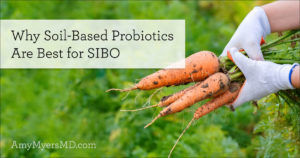

One of the most common questions I’m asked all the time is “which probiotics are best for SIBO?” You might be surprised to learn that if you have SIBO (Small Intestinal Bacterial Overgrowth), your regular probiotic could actually be exacerbating the problem. For this reason, you’ll want to take a specialized approach when it comes to your probiotic regimen to ensure you’re getting the support you need.
In this article, I’ll be highlighting the best probiotics for managing SIBO, as well as which probiotics may be fueling the fire.
What is SIBO?
Small Intestinal Bacterial Overgrowth (SIBO) occurs when the bacteria in your small intestine get out of balance and overgrow. As I always say, “Too much of a good thing can be a bad thing,” and this is true of SIBO.
Too much good or bad bacterial flora in the small intestine produces a number of gastrointestinal symptoms that interfere with your normal digestive process, including gas, bloating, and diarrhea. For a full list of the signs and symptoms, check out my article 10 Signs You Have Small Intestinal Bacterial Overgrowth (SIBO).
SIBO often goes undiagnosed because of the way its symptoms manifest in different people, sometimes showing no physical signs whatsoever. In fact, an estimated 6-15% of healthy, asymptomatic people and roughly 80% of people with IBS are actually suffering from SIBO.1
SIBO can be caused by a number of factors, including:
Diets high in sugar, alcohol, and refined carbohydrates
Damage to nerve or muscles in the gut that results in dysmotility
Physical obstructions in the gut, such as scarring from surgeries or Crohn’s disease
Medications that influence or disrupt the normal gut flora, such as antibiotics, acid-blocking drugs, and steroids
The SIBO, Leaky Gut, and Autoimmune Connection
Having SIBO can damage your mucosal lining and lead to intestinal permeability or leaky gut. In fact, besides Candida overgrowth, it is one of the main causes of leaky gut I see in my clinic.
Once your gut is leaky and toxins, viruses, bacteria and food particles are flooding your bloodstream, your immune system marks them as dangerous invaders and creates inflammation to get rid of them. As your gut remains leaky and more and more particles escape into your bloodstream, your immune system sends out wave after wave of inflammation. Eventually it becomes over stressed and begins firing less accurately. This in turn leads to autoimmunity as your own tissues end up in the cross hairs. What’s more, many of the particles that are now flooding your bloodstream look a lot like your body’s own tissues. Your immune system will then create antibodies against these substances which mistakenly attack your tissues in the process, in a phenomenon called molecular mimicry.
Probiotics: Adding Fuel to the Fire
Treating SIBO is a 3-step approach. The first step is to remove the foods that feed it, including sugar, alcohol, and carbohydrates, specifically refined carbohydrates.
Second, you want to attack the bad bacteria. The primary antibiotics used for treating SIBO are Xifaxan and Neomycin, depending on the type of gas being produced by your gut organisms (methane or hydrogen). As a natural alternative to antibiotics, I recommend Microb Clear , which is a blend of magnesium caprylate, berberine, and extracts from tribulus, sweet wormwood, grapefruit, barberry, bearberry, and black walnut.
, which is a blend of magnesium caprylate, berberine, and extracts from tribulus, sweet wormwood, grapefruit, barberry, bearberry, and black walnut.
Third, you want to restore the good bacteria with probiotics. The problem with many probiotics available on the market is that they simply don’t work for SIBO, and can actually make the problem worse.
Here’s why: The small intestine is not meant to have very much bacteria in it because it interferes with digestion and nutrient absorption. Some bacteria is necessary for these functions, so you can think of your small intestine as Goldilocks–too little or too much bacteria is bad. You want your bacteria levels to be just right for optimal digestion and absorption.
When bacteria are present in the small intestine, they are often of the lactobacillus or bifidobacterium species. And since the majority of probiotic supplements out there contain lactobacillus or bifidobacterium, using this type of probiotic is only adding to the bacteria in your small intestine and throwing fuel on the fire. For this reason, I recommend a soil-based probiotic for anyone dealing with SIBO.
The Dirt on Soil-Based Probiotics
Back in the day, we grew all our own food and pulled it straight from the ground, eating it right there without washing it. The earth is full of bacteria, and it’s where we used to get most of our probiotics. In our hyper-hygienic modern lives, we are so far removed from the dirt that grows our food that we’re missing out on some of the crucial microorganisms that populate our soil and used to populate our own microbiomes. I believe this is a big reason why digestive issues are so much more common today than they once were. That’s where soil-based probiotics come in.
Soil-Based Probiotics for SIBO
Soil-based probiotics do not exacerbate symptoms of SIBO in the way other types of probiotics can. In fact, one clue that you may have SIBO is that when you take a probiotic containing lactobacillus or bifidobacterium you have an exacerbation of your symptoms such as more gas, bloating, constipation, diarrhea or other digestive symptoms. If you are currently dealing with SIBO, it’s not recommended to take a probiotic containing lactobacillus or bifidobacterium strains until you’ve eliminated your bacterial overgrowth and repaired your gut, as these can actually worsen your SIBO.
Soil-based probiotics on the other hand will not exacerbate your symptoms or add fuel to the fire because soil-based probiotics don’t colonize the small intestine or feed the bacteria already growing there since they don’t contain lactobacillus or bifidobacterium strains, yet they still provide all the benefits of a probiotic.
Soil-based probiotics have a natural, seed-like structure that makes them hardier than lacto-based probiotics and therefore able to survive the harsh journey through the stomach with far fewer colony-forming units (CFUs) than lactobacillus based supplements.2 This is due to the formation of endospores, which can withstand stomach acid, bile salts, and pancreatic enzymes that would normally destroy the bacteria.3 What’s more, soil-based organisms know to stay in their spore state until their environment is safe. This makes them a great option for SIBO because they don’t populate the small intestine and contribute to bacterial overgrowth there, instead heading straight to the large intestine and colon where they can support vibrant health.
A 2-week double-blind clinical study of patients diagnosed with IBS demonstrated a significant reduction in symptoms when treated with a soil-based probiotic.4 Since we know that about 80% of IBS patients are likely dealing with SIBO, soil-based probiotics are an effective way to alleviate your SIBO-related symptoms as well.
Soil-Based Probiotics for Autoimmunity
Because SIBO and autoimmunity are so closely linked, you’ll be happy to learn that soil-based probiotics have also been found to be beneficial for autoimmune conditions. One specific strain of bacteria found in soil-based probiotics helps with the production of immunoglobulin A (IgA). These immunoglobulins, or antibodies, play a key role in your immune system, and I’ve found that many of my autoimmune patients tend to be low in IgA. I’ve seen a positive impact on inflammatory and autoimmune markers in these patients when their IgA levels are optimized. Additionally, IgA supports your gut repair pathways, helping to restore your gut lining so that toxins, microbes, and food particles are no longer able to escape via your bloodstream and trigger an immune response.
Superstar Strains in Soil-Based Probiotics
The unique benefits of soil-based probiotics come from the combination of organisms they contain. The three, well-studied bacterial strains found in soil-based probiotic Primal Earth are Bacillus clausi, Bacillus coagulans, and Bacillus subtilis.
are Bacillus clausi, Bacillus coagulans, and Bacillus subtilis.
1. Bacillus Clausii (B. Clausii):
Helps modulate your immune response
Assists in IgA synthesis
Antibiotic resistant for use with antibiotic treatment of SIBO
Produces bactarin, a weapon against pathogens
2. Bacillus Coagulans (B. Coagulans):
Helps the good bacteria successfully colonize in your gut
Potent immune stimulator
Long history of studied use in IBS, Crohn’s, and ulcerative colitis
3. Bacillus Subtilis (B. Subtilis)
Supports gut repair by increasing IgA and butyrate
Produces over 12 antibiotics
Ferments Vitamin K in your gut, which is essential for growth and repair
Has a positive impact on inflammatory and autoimmune markers
Widely used, safe, and effective
In addition to these specialized skills, the superior seed-like structure of soil-based probiotics make them resistant to heat, light, oxygen, and the harsh conditions of your digestive tract. This means that Primal Earth probiotics require no refrigeration and are guaranteed to last the journey to your gut alive and ready to work!
probiotics require no refrigeration and are guaranteed to last the journey to your gut alive and ready to work!
Repair Your Gut with Primal Earth
 Probiotics
ProbioticsPrimal Earth is specifically designed to mimic the most important natural flora in our paleolithic ancestors’ diets, to help restore a healthy gut balance. Primal Earth
is specifically designed to mimic the most important natural flora in our paleolithic ancestors’ diets, to help restore a healthy gut balance. Primal Earth contains the above three very well-studied strains, so it is better tolerated than other soil-based probiotics, especially when it comes to autoimmune patients.
contains the above three very well-studied strains, so it is better tolerated than other soil-based probiotics, especially when it comes to autoimmune patients.
Digestive model studies to test the efficacy of the bacterial strains contained in Primal Earth demonstrated their ability to alter the entire microbiota–a unique finding among other probiotics on the market. The organisms contained in Primal Earth
demonstrated their ability to alter the entire microbiota–a unique finding among other probiotics on the market. The organisms contained in Primal Earth have also been genetically mapped to ensure that they won’t lead to antibiotic resistance. They are perfect for frequent travelers as they require no refrigeration. Also, they are non-GMO and contain no allergens, including wheat, gluten, dairy, corn, soy, or colorings, preservatives, or dyes.
have also been genetically mapped to ensure that they won’t lead to antibiotic resistance. They are perfect for frequent travelers as they require no refrigeration. Also, they are non-GMO and contain no allergens, including wheat, gluten, dairy, corn, soy, or colorings, preservatives, or dyes.
Primal Earth Probiotic is an excellent choice if you:
Probiotic is an excellent choice if you:
Are dealing with SIBO
Have been diagnosed with a autoimmune condition
Are not experiencing success with traditional lactobacillus or bifidobacterium based probiotics
Have recently taken or are currently taking antibiotics
Have a history of high stomach acid
Want a probiotic that doesn’t need to be refrigerated
Click here to order!
The post Why Soil-Based Probiotics Are Best for SIBO appeared first on Amy Myers MD.
Amy Myers's Blog
- Amy Myers's profile
- 74 followers




